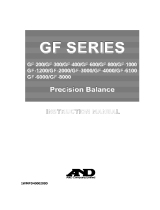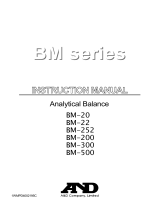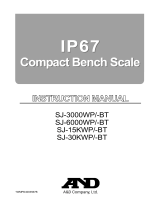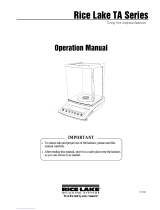
Instruction manual 1 GP series, GF-K series
Contents
Basic Operation
1. Introduction.........................................................................................................3
1-1. About This Manual...........................................................................................................3
1-2. Features............................................................................................................................3
1-3. Compliance.......................................................................................................................4
1-3-1. Compliance with FCC Rules .......................................................................................4
1-3-2. Compliance With Directives of CE mark.....................................................................4
2. Unpacking And Installing The Balance................................................................6
2-1. Installing the Balance.......................................................................................................7
3. Precautions.........................................................................................................8
3-1. Before Use........................................................................................................................8
3-2. During Use........................................................................................................................9
3-3. After Use.........................................................................................................................10
3-4. Power Supply.................................................................................................................10
4. Display Symbols And Key Operation ................................................................11
5. Weighing Units..................................................................................................12
6. Weighing...........................................................................................................14
6-1. Selecting a Weighing Unit (Mode) ................................................................................14
6-2. Basic Weighing...............................................................................................................14
6-2-1. For More Stable Weighing.........................................................................................14
6-2-2. When Using as a Mass Comparator.........................................................................14
6-2-3. When Building into a System.....................................................................................15
Adapting to the Environment
7. Weighing Speed Adjustment / Self Check Function..........................................16
7-1. Weighing Speed Adjustment.........................................................................................16
7-2. Self Check Function with Response Adjustment.........................................................17
8. Calibration.........................................................................................................18
8-1. Calibration Group...........................................................................................................18
8-2. Automatic Self Calibration.............................................................................................19
8-3. One-Touch Calibration...................................................................................................20
8-4. Calibration Using an External Weight...........................................................................21
8-5. Calibration Test Using an External Weight...................................................................22
8-6. Correcting the Internal Mass Value...............................................................................23
Functions
9. Function Switch And Initialization......................................................................25
9-1. Permit or Inhibit ..............................................................................................................25
9-2. Initializing the Balance ...................................................................................................26
10. Function Table...................................................................................................27
10-1. Sequence of the Function Table....................................................................................27
10-2. Display and Operation Keys..........................................................................................27
10-3. Details of the Function Table.........................................................................................28
10-4. Description of the Class "Environment, Display" .........................................................32
10-5. Description of the Item "Data Output Mode" ................................................................33

























